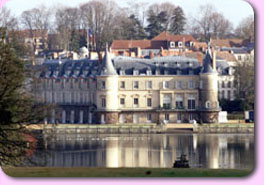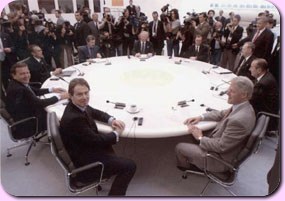The Summit's Framework
|
Summits are meetings of heads of state, like presidents, and heads of government, such as prime ministers.
|
|
The word "summit," which normally means the top of a mountain, is also used as a name for the meetings among the top leaders of countries. The "G8 summit" is the meeting once each year of the world's leading countries.
|
| |
| G8 is short for the "Group of Eight." |
|
|
Eight leading countries have joined together
in the Group of Eight, or G8 for short. These are Japan, France, the
United States, the United Kingdom, Germany, Italy, Canada, and Russia.
At the G8 summits, their leaders gather in one place.
Other meetings are also held at the same time. These are meetings of the
foreign ministers and finance ministers of each country in the Group of
Eight. The term "G8 summit" is often used as an overall description of
all these meetings, not just the one where prime ministers and presidents
get together. |
| |
| "Sherpas" are helpers who make preparations
for summits. |
| Before the leaders of countries meet with each
other, their assistants make preparations. Following instructions from their
bosses, they discuss among themselves how the discussions should be handled.
They are nicknamed "sherpas." This word comes from the Sherpa people of Nepal,
the famous mountain climbers who guide people to the top of the towering
Himalayan Mountains. In a similar way, the G8 sherpas help the leaders of
countries get to summit meetings. |
History of the Summits
|
The G8 Summits began as a response to global economic
problems.
|
Back in the 1970s, some 30 years ago, the world economy ran into serious difficulties. One cause of this was the decision by U.S. President Richard Nixon to take the dollar off the gold standard and introduce floating exchange rates as a way of defending the American economy from imports. The Japanese call this U.S. policy switch the "Nixon shock." Another shock hit a few years later when oil-producing countries announced huge hikes in the price of oil and cuts in production. This was the first of two oil crises, and it triggered a recession in many countries.
Around that time people in the most economically powerful countries began suggesting that their leaders get together to decide how to deal with common problems. The result was the first summit of the leading industrial nations. Proposed by French President Giscard d'Estaing, it took place in Rambouillet, a suburb of Paris, France, in November 1975. Six countries participated: Japan, France, the United States, the United Kingdom, Germany, and Italy.
|

|
The G6 summit has evolved into the "G8 plus 1."
|
The first summit was the only one with just six participants. At the second summit, hosted by the United States and held in Puerto Rico in 1976, Canada became a member, marking the start of Group of Seven (G7) summits. And a year later, at the 1977 summit in London, United Kingdom, the president of the European Commission also took part. This commission is the administrative organ of the European Union (EU). In those days the EU was known as the European Community (EC).
When the Cold War came to an end, the door to Russia's participation opened. At first, starting from the 1991 summit in London, the G7 leaders used the occasion mainly as a chance for exchanging views with the Russian president. Then, at the 1994 summit in Naples, Italy, Russia was invited to become a regular participant in the discussions on politics. And finally, at the 1997 summit in Denver, United States, Russia began taking part in almost all of the summit schedule, with the exception of a few sessions on subjects like the world economy. This turned the G7 into the G8 plus 1 (the "1" being the EU representative).
|
Details of the Okinawa Summit
|
Former Japanese Prime Minister Obuchi selected Okinawa and also Kyushu as summit sites.
|
Participating countries take turns hosting the summit. France started the meetings off, and it was followed by the United States, the United Kingdom, Germany, Japan, Italy, and Canada, in that order. Japan's first turn to act as host was in 1979, and it has since had two more turns, in 1986 and 1993. On each of these occasions, which came once every seven years, Japan selected Tokyo as the place for everybody to meet.
Now, in the year 2000, another seven years have passed, and it is Japan's fourth turn. This time it looked for a site outside of Tokyo, and people in quite a few places eagerly offered to have their cities or prefectures chosen. While former Prime Minister Keizo Obuchi was in office, before he fell ill and was replaced, he decided on Okinawa, Japan's southernmost prefecture, as the place to hold the main summit sessions-the discussions among the heads of state and government. He also decided upon Kyushu, the southernmost of Japan's four main islands (just north of Okinawa), as the place to hold other summit sessions. Both are good choices, since each has a long history of exchange with the rest of Asia. The official name of the gathering is the G8 Kyushu-Okinawa Summit Meeting 2000.
|
|
Kyushu's role is to host the meetings of the foreign and finance ministers.
|
Two cities in Kyushu will host the meetings of the foreign and finance ministers. The foreign ministers will gather in Miyazaki, and the finance ministers will meet in Fukuoka.
|
The summit will be a good opportunity for delivering a message on the twenty-first century.
|
|
Quite a few items are on the summit's agenda. Some are matters left over from earlier summits, including last year's summit in Cologne, Germany. There is also urgent business involving the world economy and regional conditions. And as the host, Japan has prepared its own list of topics it wants to have addressed, such as the information-technology revolution, economic growth in developing countries, and the issue of AIDS, malaria, and other infections diseases. Because the summit's year is the millennium, and because it takes place in Asia, many people are hoping that the gathering will deliver a clear message on the new century that takes Asian viewpoints into account.
|
|
 |
 |
 |
 |
 |
 |
 |
 |
 |
|
|
|
Simultaneous interpreters will keep everybody informed of what the leaders are saying.
|
|
When leaders speak during summit sessions, they normally use their native language. At the Kyushu-Okinawa summit, as at earlier summits, a team of simultaneous interpreters will be on hand to render their words into other languages as they speak.
|
|



